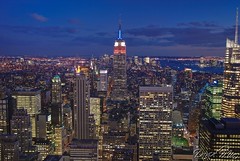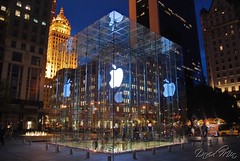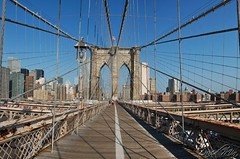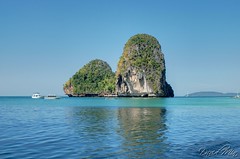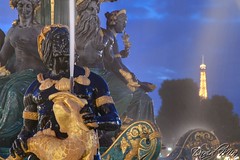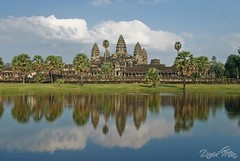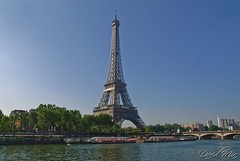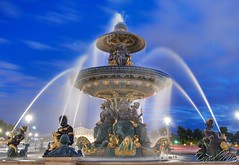Top Of The Rock is an experience in history and scenery that culminates with unparalleled views of New York City from the newly reopened Observation Deck on the 70th floor of 30 Rockefeller Center, in the heart of midtown Manhattan.
There's a certain peace at 70 stories above the city, and Top Of The Rock Observation Deck is conceived with the express purpose of keeping that peace uninterrupted. Panels of fully transparent safety glass - the only thing between visitors and the city - are crystal clear for unobstructed, open-air viewing.
The view itself is unique and astonishing. Unobstructed for 360 degrees from the 70th floor, the breathtaking landscape stretches for miles in every direction. It includes a panorama of Central Park and the northern half of Manhattan that cannot be found anywhere else. New York's other landmarks are visible as well, including the Chrysler Building, Times Square, the Hudson River, the East River, the Brooklyn Bridge, and the Statue of Liberty. It is, quite simply, the most spectacular view in New York City.
Tuesday, August 31, 2010
Monday, August 30, 2010
New York City - The Glass Cube at 5th Avenue
The store in it self is all underground except for the entrance, a 32-foot glass cube right in front of f the General Motors building opposite the Plaza Hotel and Bergdorf Goodman on 767 Fifth Avenue.
With this incredible entrance Apple has created what could be a new New York Landmark located at a very prominent location on Manhattan.
Beneath the ground level, it’s an amazing world of Apple products, accessories and fanboyzz!! There are 100 Macs and 200 iPods to try before you buy. This Fifth Avenue Apple Store is operational 24-by-7, 365 days a year – one of a kind.
With this incredible entrance Apple has created what could be a new New York Landmark located at a very prominent location on Manhattan.
Beneath the ground level, it’s an amazing world of Apple products, accessories and fanboyzz!! There are 100 Macs and 200 iPods to try before you buy. This Fifth Avenue Apple Store is operational 24-by-7, 365 days a year – one of a kind.
Sunday, August 29, 2010
New York City - Brooklyn Bridge
Walk Across the Brooklyn Bridge. One of the most famous bridges in the nation, the Brooklyn Bridge is located in New York City. It is one of the oldest and largest suspension bridges in the nation and spans more than a mile across the East River. For a time, it was even the longest suspension bridge in the world.
The bridge connects the boroughs of Brooklyn and Manhattan. In 1964, the bridge became a National Historic Landmark, a National Historic Engineering Landmark in 1983, and it is one of the most iconic pieces of New York.
One of the most popular things to do while in New York City is to walk the Brooklyn Bridge. Not everyone knows that this is possible, but close to 5,000 pedestrians and more than 2,500 cyclists cross the bridge in this manner everyday. The walk takes at least half an hour, but most people spend far more time on the bridge, taking pictures and reading the plaques that detail the history of the bridge and the city, as well as point out some interesting sights.
The bridge connects the boroughs of Brooklyn and Manhattan. In 1964, the bridge became a National Historic Landmark, a National Historic Engineering Landmark in 1983, and it is one of the most iconic pieces of New York.
One of the most popular things to do while in New York City is to walk the Brooklyn Bridge. Not everyone knows that this is possible, but close to 5,000 pedestrians and more than 2,500 cyclists cross the bridge in this manner everyday. The walk takes at least half an hour, but most people spend far more time on the bridge, taking pictures and reading the plaques that detail the history of the bridge and the city, as well as point out some interesting sights.
Wednesday, August 18, 2010
Railay Beach - Thailand
I'm gonna take a break at the end of the week for a new destination. See you at my return with new photos.
A place you just need to visit is Railey/Railay beach in Thailand. Railey is one of Thailand's most sought after beach areas. Just south of Ao Nang Beach, around a rocky headland and accessible only by boat, Railay presents a private and extraordinary world.
In just one small peninsula you'll find gorgeous white sand beaches, soaring limestone cliffs, viewpoints, caves and hidden lagoons inside the cliffs, shaped and fed by the changing tides. All within walking distance !
At Railay there are no roads, only footpaths. No buses, no cars, just local "longtail" boats. Although it's actually connected to the mainland, the spectacular Phra Nang peninsular is effectively isolated by limestone headlands and steep jungle valleys from Krabi's main holiday areas. The very picture of tropical paradise, with no roads and no hassle, Railay offers lazy days, adventure forays and chilled-out evenings.
A place you just need to visit is Railey/Railay beach in Thailand. Railey is one of Thailand's most sought after beach areas. Just south of Ao Nang Beach, around a rocky headland and accessible only by boat, Railay presents a private and extraordinary world.
In just one small peninsula you'll find gorgeous white sand beaches, soaring limestone cliffs, viewpoints, caves and hidden lagoons inside the cliffs, shaped and fed by the changing tides. All within walking distance !
At Railay there are no roads, only footpaths. No buses, no cars, just local "longtail" boats. Although it's actually connected to the mainland, the spectacular Phra Nang peninsular is effectively isolated by limestone headlands and steep jungle valleys from Krabi's main holiday areas. The very picture of tropical paradise, with no roads and no hassle, Railay offers lazy days, adventure forays and chilled-out evenings.
Sunday, August 15, 2010
Paris, France - Fountains on the Place de la Concorde
The city of Paris has some of the world's most beautiful fountains. One of the prettiest fountains can be found near the Obelisque at the Place de la Concorde.
The two fountains in the Place de la Concorde have been the most famous of the fountains built during the time of Louis-Philippe, and came to symbolize the fountains in Paris. They were designed by Jacques-Ignace Hittorff, a student of the Neoclassical designer Charles Percier at the Ecole des Beaux-Arts. The German-born Hittorff had served as the official Architect of Festivals and Ceremonies for the deposed King, and had spent two years studying the architecture and fountains of Italy.
Hittorff's two fountains were on the theme of rivers and seas, in part because of their proximity to the Ministry of Navy on the Place de la Concorde, and to the Seine. Their arrangement, on a north-south axis aligned with the obelisk of Luxor, and the Rue Royale, and the form of the fountains themselves, were influenced by the fountains of Rome, particularly Piazza Navona and the Piazza San Pietro, both of which had obelisks aligned with fountains.
The two fountains in the Place de la Concorde have been the most famous of the fountains built during the time of Louis-Philippe, and came to symbolize the fountains in Paris. They were designed by Jacques-Ignace Hittorff, a student of the Neoclassical designer Charles Percier at the Ecole des Beaux-Arts. The German-born Hittorff had served as the official Architect of Festivals and Ceremonies for the deposed King, and had spent two years studying the architecture and fountains of Italy.
Hittorff's two fountains were on the theme of rivers and seas, in part because of their proximity to the Ministry of Navy on the Place de la Concorde, and to the Seine. Their arrangement, on a north-south axis aligned with the obelisk of Luxor, and the Rue Royale, and the form of the fountains themselves, were influenced by the fountains of Rome, particularly Piazza Navona and the Piazza San Pietro, both of which had obelisks aligned with fountains.
Saturday, August 14, 2010
Siem Reap, Cambodia - Angkor Wat
If you've read anything at all about Angkor Wat, you'll probably know at least three things: Angkor is one of the most beautiful and suggestive place on the planet, the Angkor Wat Temples area is much bigger than the Angkor Temple alone, and last, nothing is homogeneous, being the temples built in different times, during a four centuries process.
Many people, when they hear the name Angkor in a conversation, they ask: "Angkor What?". Angkor Wat is one of the most beautiful and fascinating places on the planet. Made by the Khmer kings in a process that lasts almost 4 centuries, this magnificent area has been abandoned and hidden by the forest. Re-discovered by a french man about 150 years ago, Angkor Wat is ready to become one of the most visited archaeological and artistic site on the planet.
Many people, when they hear the name Angkor in a conversation, they ask: "Angkor What?". Angkor Wat is one of the most beautiful and fascinating places on the planet. Made by the Khmer kings in a process that lasts almost 4 centuries, this magnificent area has been abandoned and hidden by the forest. Re-discovered by a french man about 150 years ago, Angkor Wat is ready to become one of the most visited archaeological and artistic site on the planet.
Thursday, August 12, 2010
Niagara Falls, Canada - American Falls
The Niagara Falls are voluminous waterfalls on the Niagara River, straddling the international border between the Canadian province of Ontario and the U.S. state of New York. Niagara Falls is composed of two major sections separated by Goat Island: Horseshoe Falls, the majority of which lies on the Canadian side of the border, and American Falls on the American side.
The Niagara Falls are renowned both for their beauty and as a valuable source of hydroelectric power.
This shot was taken from the Canadian side at night.
The Niagara Falls are renowned both for their beauty and as a valuable source of hydroelectric power.
This shot was taken from the Canadian side at night.
Wednesday, August 11, 2010
Iquitos, Peru - Amazon River
Iquitos is the largest city in the Peruvian rainforest, with a population of 370,962. It is generally considered the most populous city in the world that cannot be reached by road.
Located on the Amazon River, it is a mere 106 m above sea level even though it is more than 3,000 km from the mouth of the Amazon at Belém in Brazil, on the Atlantic Ocean. Iquitos has long been a major port in the Amazon Basin. It is surrounded by three rivers: the Nanay, the Itaya, and the Amazon.
The city can be reached only by airplane or boat, with the exception of a road to Nauta, a small town roughly 100 km (62 mi) south.
The climate is hot and humid, with an average relative humidity of 85%. The wet season lasts from around November to May, with the river reaching its highest point in May. The river is at its lowest in October.
A boat tour of Belén is a common tourist attraction. Belén is an area east of Iquitos that can be accessed by foot and moto-carro both in the dry and wet seasons. However, many of the homes in this area are tethered to large poles and float upon the rising waters every year, and some homes float year-round. Where the waters begin there are often a few men with their boats who transport locals and tourists for a small fee.
Located on the Amazon River, it is a mere 106 m above sea level even though it is more than 3,000 km from the mouth of the Amazon at Belém in Brazil, on the Atlantic Ocean. Iquitos has long been a major port in the Amazon Basin. It is surrounded by three rivers: the Nanay, the Itaya, and the Amazon.
The city can be reached only by airplane or boat, with the exception of a road to Nauta, a small town roughly 100 km (62 mi) south.
The climate is hot and humid, with an average relative humidity of 85%. The wet season lasts from around November to May, with the river reaching its highest point in May. The river is at its lowest in October.
A boat tour of Belén is a common tourist attraction. Belén is an area east of Iquitos that can be accessed by foot and moto-carro both in the dry and wet seasons. However, many of the homes in this area are tethered to large poles and float upon the rising waters every year, and some homes float year-round. Where the waters begin there are often a few men with their boats who transport locals and tourists for a small fee.
Monday, August 9, 2010
Paris, France - The Eiffel Tower
The Eiffel Tower is an 1889 iron lattice tower located on the Champ de Mars in Paris that has become both a global icon of France and one of the most recognizable structures in the world. The Eiffel Tower, which is the tallest building in Paris, is the single most visited paid monument in the world; millions of people ascend it every year. Named after its designer, engineer Gustave Eiffel, the tower was built as the entrance arch for the 1889 World's Fair.
The tower stands 324 m tall, about the same height as an 81-storey building. It was the tallest man-made structure in the world from its completion until the Chrysler Building in New York City was built in 1930.The tower has three levels for visitors. Tickets can be purchased to ascend by stairs or lift to the first and second levels. The walk to the first level is over 300 steps, as is the walk from the first to the second level. The third and highest level is accessible only by lift. Both the first and second levels feature restaurants.
The tower has become the most prominent symbol of both Paris and France, often in the establishing shot of films set in the city.
The tower stands 324 m tall, about the same height as an 81-storey building. It was the tallest man-made structure in the world from its completion until the Chrysler Building in New York City was built in 1930.The tower has three levels for visitors. Tickets can be purchased to ascend by stairs or lift to the first and second levels. The walk to the first level is over 300 steps, as is the walk from the first to the second level. The third and highest level is accessible only by lift. Both the first and second levels feature restaurants.
The tower has become the most prominent symbol of both Paris and France, often in the establishing shot of films set in the city.
Sunday, August 8, 2010
Paris, France - Fountains on the Place de la Concorde
The city of Paris has some of the world's most beautiful fountains. One of the prettiest fountains can be found near the Obelisque at the Place de la Concorde.
The two fountains in the Place de la Concorde have been the most famous of the fountains built during the time of Louis-Philippe, and came to symbolize the fountains in Paris. They were designed by Jacques-Ignace Hittorff, a student of the Neoclassical designer Charles Percier at the Ecole des Beaux-Arts. The German-born Hittorff had served as the official Architect of Festivals and Ceremonies for the deposed King, and had spent two years studying the architecture and fountains of Italy.
Hittorff's two fountains were on the theme of rivers and seas, in part because of their proximity to the Ministry of Navy on the Place de la Concorde, and to the Seine. Their arrangement, on a north-south axis aligned with the obelisk of Luxor, and the Rue Royale, and the form of the fountains themselves, were influenced by the fountains of Rome, particularly Piazza Navona and the Piazza San Pietro, both of which had obelisks aligned with fountains.
The two fountains in the Place de la Concorde have been the most famous of the fountains built during the time of Louis-Philippe, and came to symbolize the fountains in Paris. They were designed by Jacques-Ignace Hittorff, a student of the Neoclassical designer Charles Percier at the Ecole des Beaux-Arts. The German-born Hittorff had served as the official Architect of Festivals and Ceremonies for the deposed King, and had spent two years studying the architecture and fountains of Italy.
Hittorff's two fountains were on the theme of rivers and seas, in part because of their proximity to the Ministry of Navy on the Place de la Concorde, and to the Seine. Their arrangement, on a north-south axis aligned with the obelisk of Luxor, and the Rue Royale, and the form of the fountains themselves, were influenced by the fountains of Rome, particularly Piazza Navona and the Piazza San Pietro, both of which had obelisks aligned with fountains.
Friday, August 6, 2010
Paris, France - Fountains on the Place de la Concorde
The city of Paris has some of the world's most beautiful fountains. One of the prettiest fountains can be found near the Obelisque at the Place de la Concorde.
The two fountains in the Place de la Concorde have been the most famous of the fountains built during the time of Louis-Philippe, and came to symbolize the fountains in Paris. They were designed by Jacques-Ignace Hittorff, a student of the Neoclassical designer Charles Percier at the Ecole des Beaux-Arts. The German-born Hittorff had served as the official Architect of Festivals and Ceremonies for the deposed King, and had spent two years studying the architecture and fountains of Italy.
Hittorff's two fountains were on the theme of rivers and seas, in part because of their proximity to the Ministry of Navy on the Place de la Concorde, and to the Seine. Their arrangement, on a north-south axis aligned with the obelisk of Luxor, and the Rue Royale, and the form of the fountains themselves, were influenced by the fountains of Rome, particularly Piazza Navona and the Piazza San Pietro, both of which had obelisks aligned with fountains.
The two fountains in the Place de la Concorde have been the most famous of the fountains built during the time of Louis-Philippe, and came to symbolize the fountains in Paris. They were designed by Jacques-Ignace Hittorff, a student of the Neoclassical designer Charles Percier at the Ecole des Beaux-Arts. The German-born Hittorff had served as the official Architect of Festivals and Ceremonies for the deposed King, and had spent two years studying the architecture and fountains of Italy.
Hittorff's two fountains were on the theme of rivers and seas, in part because of their proximity to the Ministry of Navy on the Place de la Concorde, and to the Seine. Their arrangement, on a north-south axis aligned with the obelisk of Luxor, and the Rue Royale, and the form of the fountains themselves, were influenced by the fountains of Rome, particularly Piazza Navona and the Piazza San Pietro, both of which had obelisks aligned with fountains.
Wednesday, August 4, 2010
Vancouver Island, Canada - Cape Scott
Cape Scott Provincial Park is a 21,849 hectare, rugged coastal wilderness at the northwest tip of Vancouver Island. The park is characterized by 64 kilometers of spectacular ocean frontage, including about 23 kilometers of beaches, running from Nissen Bight in the north to San Josef Bay in the south. Rocky promontories and headlands intersperse wide sandy beaches.
The heavy rainfalls and violent windstorms of the Cape Scott area have shaped its history. Annual precipitation, almost totally in the form of rain, is between 375 and 500 centimeters. Even in summer, prolonged sunny periods are a rarity. High winds, rain and generally stormy conditions can be expected at any time of the year.
To access to this piece of paradise, it is a little bit complicated ! After a couple hours of driving, at the end of the road, you can park your car and hike along a beautiful, yet easy, wooded trail until reaching the Pacific Ocean, beyond a wide stretch of soft sandy beach. But the best part is the tiny cove, with rocky outcroppings right on the beach. There are even caves and miniature bonsai trees! More amazing than it might sound, this sight made the long trip more than worthwhile!
The heavy rainfalls and violent windstorms of the Cape Scott area have shaped its history. Annual precipitation, almost totally in the form of rain, is between 375 and 500 centimeters. Even in summer, prolonged sunny periods are a rarity. High winds, rain and generally stormy conditions can be expected at any time of the year.
To access to this piece of paradise, it is a little bit complicated ! After a couple hours of driving, at the end of the road, you can park your car and hike along a beautiful, yet easy, wooded trail until reaching the Pacific Ocean, beyond a wide stretch of soft sandy beach. But the best part is the tiny cove, with rocky outcroppings right on the beach. There are even caves and miniature bonsai trees! More amazing than it might sound, this sight made the long trip more than worthwhile!
Tuesday, August 3, 2010
Paris, Pont Alexandre III
Pont Alexandre III is an arch bridge that spans the Seine, connecting the Champs-Élysées quarter and the Invalides and Eiffel Tower quarter, widely regarded as the most ornate, extravagant bridge in Paris.
The bridge, with its exuberant Art Nouveau lamps, cherubs, nymphs and winged horses at either end, was built between 1896 and 1900. It is named after Tsar Alexander III, who had concluded the Franco-Russian Alliance in 1892. His son Nicholas II laid the foundation stone in October 1896. The style of the bridge reflects that of the Grand Palais, to which it leads on the right bank.
The construction of the bridge is a marvel of 19th century engineering, consisting of a six-metre high single span steel arch. The design, by the architects Joseph Cassien-Bernard and Gaston Cousin, was subject to strict controls that prevented the bridge from obscuring the view of the Champs-Élysées or the Invalides.
The bridge, with its exuberant Art Nouveau lamps, cherubs, nymphs and winged horses at either end, was built between 1896 and 1900. It is named after Tsar Alexander III, who had concluded the Franco-Russian Alliance in 1892. His son Nicholas II laid the foundation stone in October 1896. The style of the bridge reflects that of the Grand Palais, to which it leads on the right bank.
The construction of the bridge is a marvel of 19th century engineering, consisting of a six-metre high single span steel arch. The design, by the architects Joseph Cassien-Bernard and Gaston Cousin, was subject to strict controls that prevented the bridge from obscuring the view of the Champs-Élysées or the Invalides.
Monday, August 2, 2010
Cruz del Condor Lookout, Peru
Colca Canyon is a canyon of the Colca River in southern Peru. It is located about 160 km northwest of Arequipa. It is more than twice as deep as the Grand Canyon in the United States at 4,160 m. However, the canyon's walls are not as vertical as those of the Grand Canyon.
The canyon is home to the Andean Condor, a species that has seen worldwide effort to preserve it. The condors can be seen at fairly close range as they fly through the canyon walls and are an increasingly popular attraction. 'Cruz del Condor' is a popular tourist stop to view the condors, the pass where condors soar gracefully on the rising thermals occurring as the air warms. The condors are best seen in the early morning and late afternoon when they are hunting. At this point the canyon floor is 1,200 m below the rim of the canyon.
The canyon is home to the Andean Condor, a species that has seen worldwide effort to preserve it. The condors can be seen at fairly close range as they fly through the canyon walls and are an increasingly popular attraction. 'Cruz del Condor' is a popular tourist stop to view the condors, the pass where condors soar gracefully on the rising thermals occurring as the air warms. The condors are best seen in the early morning and late afternoon when they are hunting. At this point the canyon floor is 1,200 m below the rim of the canyon.
Sunday, August 1, 2010
Paris, France - Notre Dame de Paris
The Gothic loftiness of Notre-Dame dominates the Seine and the Ile-de-la-Cité as well as the history of Paris.
Notre-Dame de Paris is a church, a place of Roman Catholic worship, where Christians come together to pray. It opens its doors to people to participate in services or to freely visit the cathedral all year long.
Notre Dame de Paris was among the first buildings in the world to use the flying buttress (arched exterior supports). The building was not originally designed to include the flying buttresses around the choir and nave. After the construction began and the thinner walls (popularized in the Gothic style) grew ever higher, stress fractures began to occur as the walls pushed outward. In response, the cathedral's architects built supports around the outside walls, and later additions continued the pattern.
For a look at the upper parts of the church, the river, and much of Paris, climb the 387 steps to the top of one of the towers.
Notre-Dame de Paris is a church, a place of Roman Catholic worship, where Christians come together to pray. It opens its doors to people to participate in services or to freely visit the cathedral all year long.
Notre Dame de Paris was among the first buildings in the world to use the flying buttress (arched exterior supports). The building was not originally designed to include the flying buttresses around the choir and nave. After the construction began and the thinner walls (popularized in the Gothic style) grew ever higher, stress fractures began to occur as the walls pushed outward. In response, the cathedral's architects built supports around the outside walls, and later additions continued the pattern.
For a look at the upper parts of the church, the river, and much of Paris, climb the 387 steps to the top of one of the towers.
Subscribe to:
Posts (Atom)
